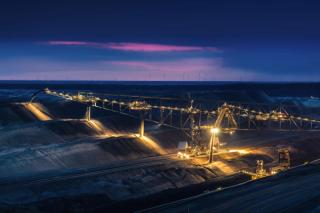
Powering the future of mining: Why haulage electrification matters
by Jasper Schrijvers , Matthew Hoare
View post

The government has set out ambitious targets to achieve net zero by 2050, but has it really considered how complex and antiquated its energy structure is? Andrew Bright explores how overstretched transmission operators and overly complicated structures within distribution network operators is making the UK a far less attractive energy market to invest in and presents possible solutions to resolve this.
The UK Government has set out its plans to achieve a net zero position, and fundamental to that is the changes to how we generate and source our electricity. Renewables now make up nearly half of the UK’s electricity generation, but there are a number of hurdles that need to be overcome if we are to continue on this positive trajectory to greener energy.
In order to address this and to encourage continued investment in the UK renewables marketplace, the Government set out its Green Finance Strategy as a way to continue in ‘the race to finance the green Industrial Revolution.’ The strategy recognises that to decarbonise within the next 27 years and to meet the UK’s environmental objectives, there will need to be extraordinary levels of investment in technologies, services and, importantly, infrastructure.
A major challenge facing renewable projects is gaining access to a grid connection in the near future. Deploying generation relies predominantly on being able to connect to the existing grid infrastructure, however, the network is largely seen as being at capacity. One of the reasons for this, is the way that it is modelled. We would argue that the grid is at a theoretical capacity, rather than being truly at capacity. A change of approach on this point would “free up” grid capacity at limited additional cost.
Due to capacity constraints, amongst other things, the transmission operator (National Grid Electricity System Operator – NGESO) and distribution network operators (DNOs) are giving connection dates of up to a decade away in some cases. Investors are therefore increasingly questioning whether the UK market is the right one in which to spend their money. Whilst the UK remains an attractive market, due to its regulation and strong governance, if investors are not able to start to see a return for ten years, many will inevitably begin to look further afield.
This could lead to further frustration in the UK renewables market, as investors who want to invest see projects facing significant delays due to difficulties in accessing the grid, coupled with uncertainty around the final costs due to significant market volatility in both capital costs, funding costs and wholesale energy prices.
As renewable generation has grown, it has primarily been connected to the distribution network operated by six DNOs who operate across the 14 DNO regions of the UK. Over the past 15 years the demands on those DNOs have increased significantly, with hundreds, if not thousands, of applications being made and processed per annum in some areas. The DNOs have been required to adapt their base resources in an effort to adapt to and keep pace with this level of increased activity.
This is also impacting the transmission network due to increased reverse power flow at the transmission-distribution boundary and increased transmission level applications which has seen a surge in developers seeking to connect larger projects at transmission level. Since 2018, NGESO has seen 10 times increase in connection applications across all technologies.
Additionally, once a connection offer has been accepted, it is considered contracted generation. Recent NGESO analysis shows that only 30 to 40 percent of projects in the queue are completed. However, as the queue operates on a first-come, first-served basis, projects further up the queue can hold back those that are more readily able to proceed, even if those further up the queue are not yet ready to generate electricity.
Historically, the milestones and timeframes set out in connection agreements have not been rigorously enforced, stunting subsequent applications. To address this, DNOs and the Electricity System Operator (ESO) are starting to become more stringent with the time limitations on applications but any congestion is going to take a number of years to clear even with increased resource dedicated to this task.
With fossil fuelled power stations typically located in areas of high demand and with the ability to readily transport or pipe the high-density energy resource to a generating station, such as coal or gas, the grid was set up to accommodate this situation. This is both in terms of the physical grid infrastructure and the charging regime we see today applied to access the grid. However, renewable generation is developed where the resource is located and this can be far from centres of use; such as offshore wind or wind farms based in more remote parts of Scotland. This also includes other marine renewable technologies such as tidal flow devices in the Pentland Firth, for example. These provide huge opportunities to harness energy to support the UK’s net zero ambitions.
Essentially, the resource is where there is very little demand, and demand where there is little resource, thus requiring increased need to transmit power over greater distances. This is putting huge pressure on the DNOs and the Transmission Operators to deliver new infrastructure.
Additionally, developers are faced, in many locations, with high use of system charges due to increasingly out-of-date charging methodologies and the greater distances required for the power to be connected. So, we currently have a system that penalises investors for seeking to deliver a renewable energy development in a location where the energy generation can take place.
What can be done to improve the situation? The ESO is already seeking further reforms to the system through improvements in queue management, offering Transmission Equivalent Capacity (TEC) amnesties, meaning renewable energy generators can terminate or reduce their TEC without penalty. TEC being a measure of the amount of grid capacity that a generator needs in order to connect to the grid, as well as enforcement of connection agreement milestones.
Other potential solutions would be to consider the actual system use in the design process. Developers are required to apply for the full export capacity of the proposed development. But for a windfarm, the project may only achieve its full generation capacity for 25 to 45 percent of the time, depending on the wind resource. Solar PV systems in the UK are lower still, at around 11 percent.
The general absence of dynamic modelling means we have a grid system that is frequently over-engineered for a lot of the assets connected to it whilst simultaneously limiting further connections based on a very narrow band of potential peak generation that does not necessarily account for the real-world situation. Contracted generation does not align with actual generation.
If partial capacity were to be awarded that would enable developers to fast-track their projects, with additional capacity being awarded as and when the grid and the project develops. This flexible approach could free up a lot of projects in a congested marketplace, rather than the current binary approach that is leaving many developers and investors inert. Additionally, it would have a positive impact on investor confidence and reinforce the UK’s position in the drive for net zero. This would be good for business planning, skills investment and wider supply chain developments.
To help navigate this complex and changing landscape, it is vital for developers to seek guidance and work closely with relevant experts who understand the development life cycle of their grid connection projects.
The UK’s grid structure was designed for a bygone age and is now having to play catch up. The UK renewables market has created a perfect storm; there are emerging technologies and multiple renewable projects in the pipeline, but we cannot get them online at the pace needed. We have an apparent lack of capacity, both in terms of physical assets and equipment and in terms of people with the required knowledge and skills to bring projects to fruition. This means investors are increasingly concerned by the idea of stranded assets or of seeing no return on projects for up to ten years or more.
To avoid losing a significant portion of investment in the UK renewable energy market, the Government must take action to enable developers to access the grid and ensure renewable energy investors can realise their investments. Stranded assets that cannot be connected to the grid are bad for business, bad for the Government’s ambitious net zero targets and bad for climate change.

by Jasper Schrijvers , Matthew Hoare

by Clodagh Connolly, Nicola Inge, Andres Schottlaender

by Michelle Gluck, Jim McKinley